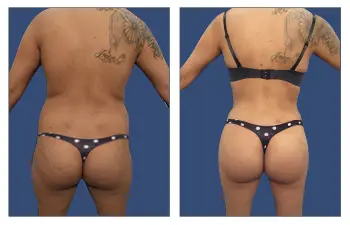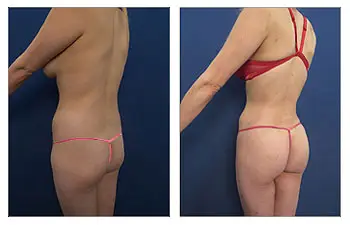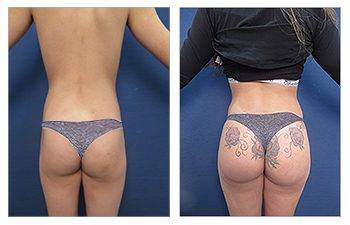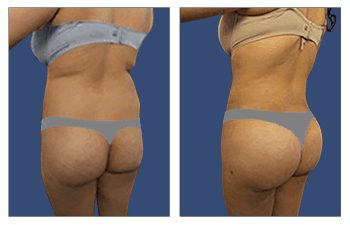Introduction to Should I Gain Weight Before a BBL?
Deciding to undergo a Brazilian Butt Lift (BBL) is a personal choice that many individuals make to enhance their body shape and achieve their desired aesthetic. One question that frequently arises during the decision-making process is whether it is necessary to gain weight before the procedure. This is an important consideration as gaining weight can affect the overall outcome of the BBL.
However, the correct answer is not what you might think! In this article, we will explore the reasons why some individuals opt to gain weight before a BBL, the supposed benefits and more importantly, the drawbacks of this approach, and provide insight into whether it is wise to gain weight prior to undergoing this popular cosmetic procedure.
Am I too skinny for a Brazilian Butt Lift?
Minimum requirements for a Brazilian Butt Lift (BBL) procedure typically include being in good general health and having enough excess fat in other areas of the body that can be harvested for the fat transfer. Generally, a patient needs to have a body mass index (BMI) of at least 20 to be eligible for a BBL. The BMI is a calculated value based on a person’s height and weight, and it helps determine if a person is within a healthy weight range. Additionally, a candidate for a BBL should not have any underlying medical conditions that could increase the risks associated with surgery.
Being too skinny can affect a person’s eligibility for the Brazilian Butt Lift procedure. Since a BBL involves fat grafting, there needs to be enough excess fat available in other areas of the body to harvest for the transfer. If a person is too skinny and lacks sufficient fat deposits, there may not be enough fat to achieve the desired results. In such cases, the surgeon may recommend alternative procedure such as a buttock implant.
Potential alternatives for achieving a fuller buttocks when a Brazilian Butt Lift is not suitable include buttock implants, where silicone implants are surgically placed, or buttock augmentation with dermal fillers such as Sculptra or Radiesse. However, it is important to discuss these options with a qualified buttock surgeon who can assess an individual’s specific situation and provide personalized recommendations.
Will I get more volume if I gain weight before a BBL?
Weight gain can actually have a negative impact on volume increase in a Brazilian Butt Lift (BBL) procedure. A BBL involves transferring fat from other areas of the body to enhance the shape and size of the buttocks. When a patient gains weight before undergoing a BBL, there is an increased availability of donor fat volume for the procedure.
During a BBL, excess fat is typically removed from areas such as the abdomen, hips, or thighs through liposuction. This fat is then carefully re-injected into the buttocks to create a fuller and more rounded appearance. Therefore, weight gain can provide a larger supply of fat for the fat transfer process, resulting in a greater harvest volume. However, this does not translate into larger volumes of fat transfer to the buttock.
The desired outcome of a BBL is to achieve a more voluptuous and contoured buttock shape. By gaining weight before the procedure, patients may think that this will translate into more fat volume transferred to the buttock. However, this is farthest from the truth! To appreciate this misconception, we must discuss fat cell physiology.
What happens to a fat cell when you gain weight
When you gain weight, your fat cells get larger and not more in number. This important fact translates into appreciating why weight gain is not an effective means of improving your BBL outcomes.
The fact of the matter is that when you harvest fat cells they must be retrieved using liposuction cannulas that has small slits. When the fat gets sucked through the cannula holes, it can get mechanically traumatized and even be injured. As a result, the larger the fat cell the less likely it is that it will survive the transplant process without being mechanically damaged.
Additionally, fat cells that are transplanted are transplanted as grafts, meaning that they initially lack a blood supply. As such, they must live off of a process called diffusion. Diffusion describes the process of nutrients literally following an osmolarity gradient to and from the cells.
Eventually, over the span of three to four days, the cell will establish its blood flow and a more secure vascular system. However, during its infancy stage, it behooves the cell to retain the most surface areas to volume ratio. As a result, smaller cells are more likely to survive during these times than larger cells.
THE WEIGHT GAIN PERSPECTIVE:
Weight gain can be attributed to a combination of factors, including genetics, a sedentary lifestyle, unhealthy diet choices, stress, and medication side effects.
Genetics plays a significant role in determining an individual’s susceptibility to weight gain. Some people may inherit genes that cause them to store more fat or have a slower metabolism, making it easier for them to gain weight. However, it is important to note that genetics do not solely determine a person’s weight, as lifestyle choices can also have a significant impact.
A sedentary lifestyle, characterized by lack of physical activity, can contribute to weight gain. Regular exercise is crucial for maintaining a healthy weight as it helps burn calories and build muscle mass. In contrast, a lack of exercise leads to a decrease in calorie expenditure, resulting in weight gain over time.
Unhealthy diet choices, such as consuming high-calorie and processed foods, can also contribute to weight gain. These foods are often low in nutrients and high in fat, sugar, and salt, leading to overconsumption and weight gain. Additionally, the convenience of fast food and the prevalence of sedentary behaviors can further contribute to poor dietary choices.
Stress is another factor that can lead to weight gain. When stressed, some individuals turn to food as a coping mechanism, consuming high-calorie comfort foods. Furthermore, stress hormones can increase appetite and promote fat storage, leading to weight gain.
Certain medications, such as antidepressants, antipsychotics, and corticosteroids, can have side effects that promote weight gain. These medications may alter metabolism, increase appetite, or cause fluid retention, making weight management challenging for individuals taking them.
Excessive weight gain can result in several health risks, including obesity, heart disease, and diabetes. Obesity greatly increases the risk of developing chronic conditions such as type 2 diabetes, high blood pressure, and certain types of cancer. It also negatively impacts cardiovascular health, as excess weight puts strain on the heart, leading to an increased risk of heart disease and stroke.
In conclusion, weight gain can be influenced by a variety of factors, including genetics, a sedentary lifestyle, unhealthy diet choices, stress, and medication side effects. These factors can have detrimental effects on an individual’s health, increasing the risk of obesity, heart disease, and diabetes. Adopting a balanced diet, engaging in regular physical activity, managing stress effectively, and closely monitoring medication side effects can all contribute to maintaining a healthy weight and reducing associated health risks.
KEY CONSIDERATIONS BEFORE YOUR BBL
Before undergoing a Brazilian Butt Lift (BBL), several key considerations should be taken into account. Firstly, the patient’s overall health is of utmost importance. It is crucial that the patient is in good overall health and does not have any existing medical conditions that could increase the risks associated with surgery. This will be assessed during the pre-operative consultation with the surgeon.
Another important factor to consider is the patient’s body mass index (BMI). Patients with a BMI over 30 may be advised to lose weight before the surgery, as this can help achieve better results and reduce the risk of complications. A healthy BMI also ensures that the patient’s body proportions will be balanced after the BBL.
Additionally, the patient’s expectations should be realistic. It is important to have a clear understanding of what the procedure can and cannot achieve, as well as the limitations and potential risks involved. Open communication with the surgeon is key to ensure that the patient’s expectations align with what can be realistically achieved.
Choosing the right surgeon is crucial. It is essential to select a board-certified plastic surgeon who specializes in Brazilian Butt Lifts. Researching the surgeon’s credentials, experience, and patient reviews can help ensure a successful outcome.
Lastly, the recovery process should be considered. The recovery period after a BBL can be extensive, often requiring several weeks of rest and limited physical activity. It is important to have arrangements in place for the recovery period, including assistance with daily tasks and adherence to post-operative care instructions.
Where is fat taken from during a BBL?
During a Brazilian Butt Lift (BBL), fat is commonly harvested from specific areas of the body through liposuction. The goal is to extract excess fat from unwanted areas and transfer it to the buttocks to enhance their shape and volume.
The donor sites for a BBL typically include the abdomen, back, hips, thighs, and flanks. These areas are chosen because they tend to accumulate excess fat, which can be utilized to create a more curvaceous and proportionate butt.
The abdomen is a popular donor site as it often has pockets of stubborn fat that can be removed. The back is another common area, especially the upper and lower back, as it can contribute to a more defined waist and enhanced buttock projection. The hips, specifically the love handle area, are also frequently targeted to achieve a more hourglass figure. The thighs, including the inner and outer thighs, can be utilized to further enhance the buttock shape. Lastly, the flanks or the sides of the waist can be a great source for fat grafting, creating a smoother waistline and rounder buttocks.
In summary, fat is harvested from the abdomen, back, hips, thighs, and flanks during a BBL. These areas are chosen for their ability to provide an ample supply of excess fat that can be transferred to achieve the desired buttock augmentation. Liposuction is employed to remove the fat from these donor sites, which is then purified and injected into the buttocks to create a more shapely and curvaceous appearance.
How to prepare for a BBL
Preparing for a Brazilian Butt Lift (BBL) procedure involves several important steps to ensure a smooth and successful surgery. Here are the specific guidelines to follow:
1. Maintain a stable weight: It is crucial to maintain a stable weight before the BBL procedure. Fluctuations in weight can affect the final outcome, so try to maintain a consistent weight prior to surgery.
2. Consult with a board-certified plastic surgeon: Schedule a consultation with a trusted, board-certified plastic surgeon who specializes in BBL. During this consultation, discuss your goals, expectations, and medical history.
3. Review medications: Provide your surgeon with a complete list of medications, including any over-the-counter drugs or supplements you are currently taking. Some medications may need to be adjusted or temporarily discontinued before surgery to minimize complications.
4. Follow preoperative instructions: Your surgeon will provide detailed preoperative instructions that may include restrictions on eating and drinking prior to surgery, specific preparations to make at home, and transportation arrangements to the surgical facility. Following these instructions diligently is crucial to ensure a safe and successful surgery.
5. Purchase compression garments: Your surgeon may recommend purchasing compression garments, which help reduce swelling and optimize the healing process. These garments should be purchased prior to the procedure, and your surgeon can provide specific recommendations on the type and size to buy.
By following these guidelines and preparing in advance, you can help ensure the best possible results and a smooth recovery from your BBL procedure.
Prepare for a successful BBL
Preparing for a successful Brazilian Butt Lift (BBL) procedure involves several important steps.
1. Schedule a consultation: Begin by scheduling a consultation with a board-certified plastic surgeon who specializes in BBL procedures.
2. Discuss goals and medical history: During the consultation, clearly communicate your desired outcome and expectations for the BBL. Be honest about your medical history, including any previous surgeries, allergies, or medical conditions.
3. Review medications: Provide a complete list of all medications, supplements, and vitamins you are currently taking. The surgeon will review these to ensure there are no contraindications or potential complications. It may be necessary to adjust or temporarily stop certain medications prior to surgery.
4. Maintain a stable weight: It is important to maintain a stable weight leading up to the procedure. Dramatic weight fluctuations can impact the final results of the BBL.
5. Follow preoperative instructions: The surgeon will provide specific instructions to follow in the weeks leading up to the procedure. This may include restrictions on eating or drinking, avoiding certain medications or supplements, and stopping smoking. Following these instructions is crucial for a successful outcome.
6. Purchase compression garments: Prior to the surgery, you will need to purchase compression garments. These garments help reduce swelling, provide support, and aid in the healing process. The surgeon will provide recommendations on the type and size of compression garments needed.
By carefully following these steps, you can adequately prepare for a successful BBL procedure. Remember to consult with a qualified surgeon and closely adhere to their instructions for the best possible results.
What Happens If I Gain Weight After a BBL?
Gaining weight after undergoing a Brazilian Butt Lift (BBL) procedure can have certain consequences that may affect the results achieved through the surgery. The BBL is a popular cosmetic surgical procedure designed to enhance the shape and size of the buttocks through fat transfer. While the surgery can yield long-lasting results, weight fluctuation can potentially impact the outcome. Understanding the potential impacts of weight gain after a BBL is essential for maintaining the desired appearance of the buttocks and overall satisfaction with the procedure.
What happens if I gain weight after a BBL?
Gaining weight after a Brazilian Butt Lift (BBL) surgery can have various outcomes that may impact the results. One potential outcome is the enlargement of both native and transferred fat cells in the buttocks. Native fat cells, which are already present in the buttocks prior to surgery, can increase in size due to weight gain. Moreover, the transplanted fat cells from other parts of the body into the buttocks can also expand if weight is gained.
The impact of gaining weight after a BBL can potentially alter the original outcome. The advantage of gaining weight after a BBL is that the buttock will get even larger if this is in your best interest. In contrast, if you are happy with your buttock size, then gaining weight might make you even larger! Another negative is that gaining weight may also compromise your contour throughout your body. Mainly, any areas that have a higher density of fat may also increase in size.
Conclusion: Should I Gain Weight Before BBL Surgery?
In conclusion, gaining weight before undergoing a Brazilian Butt Lift (BBL) surgery is not recommended. The importance of weight and fat levels in relation to the procedure lies in the ability to harvest fat from one area of the body and transfer it to the buttocks. However, this does not mean that patients should deliberately increase their weight prior to the surgery.
During a BBL surgery, the surgeon removes excess fat from areas such as the abdomen, thighs, or love handles through liposuction. This harvested fat is then processed and injected into the buttocks to enhance their shape and size. While having sufficient fat is essential for the success of the procedure, gaining weight before surgery is not the recommended approach.
Ideally, patients should maintain a stable and healthy weight before their BBL surgery. This ensures that the fat being transferred is of high quality and allows the surgeon to achieve the desired results. If a patient gains weight before the procedure, the fat
cells may become enlarged, making it more difficult for the surgeon to extract the fat during liposuction without injuring them. In addition, it reduces survival potential during the osmosis period. Finally, gaining weight can increase the risks associated with surgery, such as complications during anesthesia and a longer recovery period.
In conclusion, it is not prudent to gain weight before undergoing a BBL surgery. Patients should aim for a stable and healthy weight to optimize the results of the procedure and minimize potential risks.



























